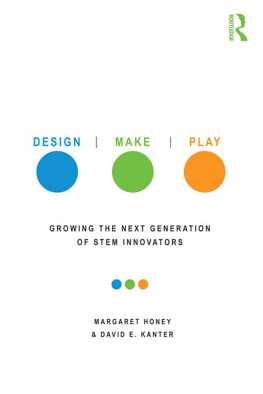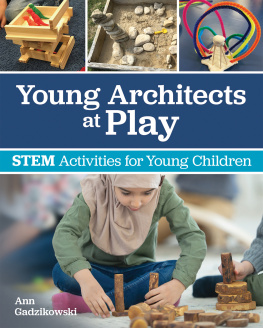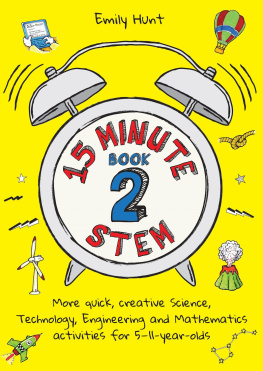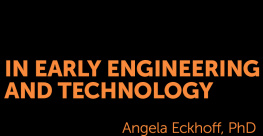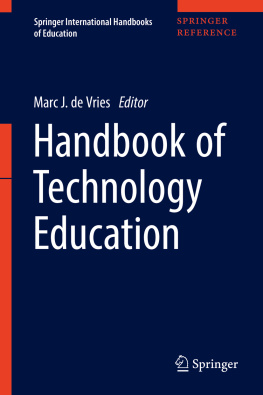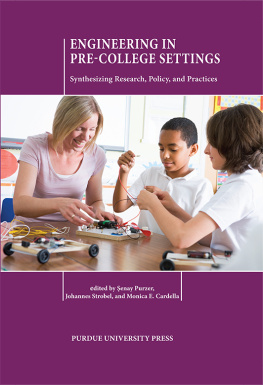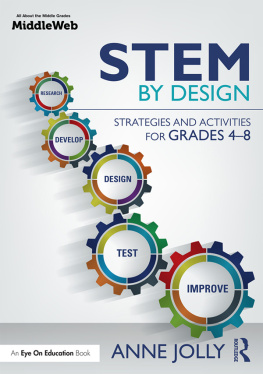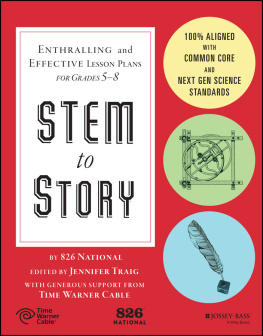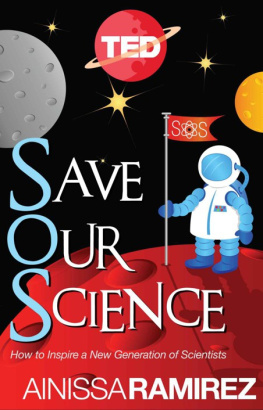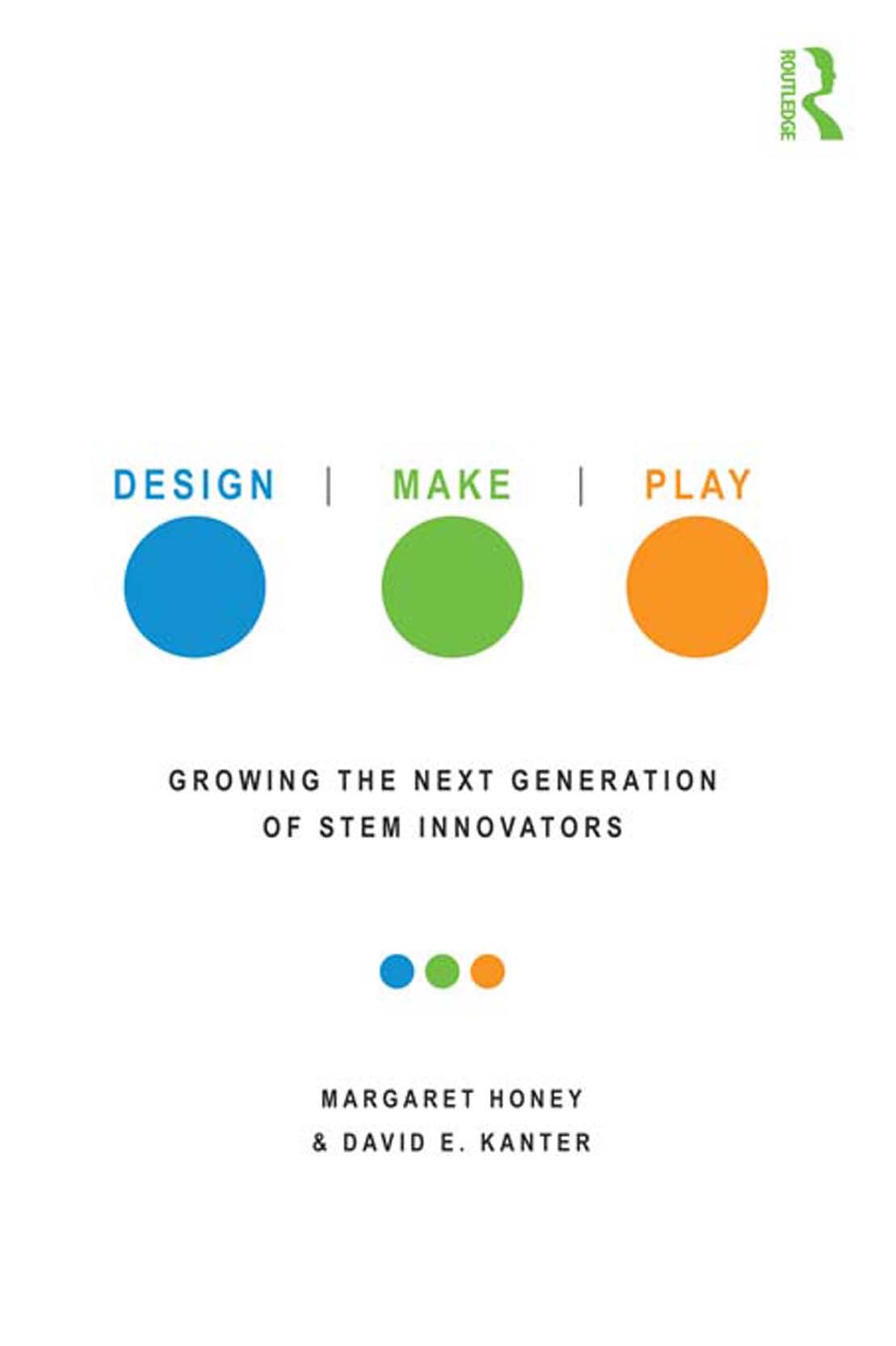D ESIGN , M AKE , P LAY
The case for the urgent need to inspire more young people to pursue college and career in science, technology, engineering, and mathematics is irrefutable. Our leadership abroad and quality of life at home depend upon it. Now comes this delightful, thoughtful, and practical book that tells us how to move forward. Using real-world examples, it shows us how to ignite passion, stimulate learning, and equip a diverse generation of innovators and makers. If you care about the future of our country, you should read this book and then put its lessons to work. Few things are as important.
Ursula Burns, Chairwoman and CEO, Xerox Corporation
In our digitally interconnected world, it is possible to forget the importance of children touching and making things as a key element of enhancing their learning. Touching and making sparks their imaginations and excites them about science and engineering. The idea of time together to design, and actually touch and make things, as part of play, is important to enhancing our childrens education. This book elucidates the important role of extracurricular learning that takes place outside of the formal school setting. Design, Make, Play is a book that every individual interested in STEM education and our childrens overall educational progress should read.
Shirley Ann Jackson, Ph.D., President, RensselaerPolytechnic Institute
Margaret Honey and David Kanter have created a thought-provoking volume on one of contemporary educations most pressing challenges: how to ensureand further, enhanceengaging STEM learning at Americas schools in the 21st century. Universities, facing the prospect of a dwindling pipeline of STEM-qualified students, have a direct stake in the outcomes. By showcasing cutting-edge methods, the contributors argue convincingly for the power of creative, hands-on instructional play in fostering the love of learning critical for success in school, college, and far beyond.
John Sexton, President, New York University
Design, Make, Play is a wonderful and useful book. (In fact, any book with a chapter entitled "No Bored Kids" is bound to be helpful.) Through multiple case studies, it shows in concrete ways how to initiate, integrate, and promote the learning and joy of science through discovery and doing. Many pay lip service to discovery-based learning, but this book presents the real thing. This book accomplishes something else very importantit has discovered the T and E in STEM through its cogent presentations about tinkering and about the Maker movement and its philosophy. This is a great read and guide to those interested in retooling STEM education for early learners.
Charles Vest, President, National Academy of Engineering; President Emeritus, Massachusetts Institute of Technology
Design, Make, Play: Growing the Next Generation of STEM Innovators is a resource for practitioners, policymakers, researchers, and program developers that illuminates creative, cutting edge ways to inspire and motivate young people about science and technology learning. The book is aligned with the National Research Councils new Framework for Science Education, which includes an explicit focus on engineering and design content, as well as integration across disciplines. Extensive case studies explore real-world examples of innovative programs that take place in a variety of settings, including schools, museums, community centers, and virtual spaces. Design, Make, and Play are each presented as learning methodologies that have the power to rekindle childrens intrinsic motivation and innate curiosity about STEM (science, technology, engineering, and mathematics) fields. A companion website (dmp.nysci.org) showcases rich multimedia that brings the stories and successes of each programand the students who learn thereto life.
Dr. Margaret Honey is President and CEO of the New York Hall of Science.
Dr. David E. Kanter is Director of the Sara Lee Schupf Family Center for Play, Science, and Technology Learning at the New York Hall of Science.
D ESIGN , M AKE , P LAY
G ROWING THE N EXT G ENERATION
OF STEM I NNOVATORS
EDITED BY
MARGARET HONEY
DAVID E. KANTER

First published 2013
by Routledge
711 Third Avenue, New York, NY 10017
Simultaneously published in the UK
by Routledge
2 Park Square, Milton Park, Abingdon, Oxon OX14 4RN
Routledge is an imprint of the Taylor & Francis Group, an informa business
2013 Taylor & Francis
The right of the editors to be identified as the authors of the editorial material, and of the authors for their individual chapters, has been asserted in accordance with sections 77 and 78 of the Copyright, Designs and Patents Act 1988.
All rights reserved. No part of this book may be reprinted or reproduced or utilized in any form or by any electronic, mechanical, or other means, now known or hereafter invented, including photocopying and recording, or in any information storage or retrieval system, without permission in writing from the publishers.
Trademark notice: Product or corporate names may be trademarks or registered trademarks, and are used only for identification and explanation without intent to infringe.
Library of Congress Cataloging in Publication Data
Design, make, play: growing the next generation of STEM innovators / edited by Margaret Honey and David E. Kanter.
p. cm.
Includes bibliographical references and index.
1. ScienceStudy and teachingActivity programs.
2. TechnologyStudy and teachingActivity programs.
3. MathematicsStudy and teachingActivity programs.
I. Honey, Margaret. II. Kanter, David (David E.)
Q181.D369 2013
500.1dc23
2012029542
ISBN: 978-0-415-53916-6 (hbk)
ISBN: 978-0-415-53920-3 (pbk)
ISBN: 978-0-203-10835-2 (ebk)
Typeset in Minion
by Florence Production Ltd, Stoodleigh, Devon, UK
C ONTENTS
C ONTRIBUTORS
Philip Bell pursues a cognitive and cultural program of research across diverse environments focused on how people learn about STEM in ways that are personally consequential to them. He is an Associate Professor of the Learning Sciences at the University of Washington, Seattle, where he directs the Institute for Science and Math Education and co-directs the NSF-funded Learning in Informal and Formal Environments (LIFE) center. He was a member of the committee that authored the National Research Council Framework for K-12 Science Education.
Dorothy Bennett is Director of Design-Based Learning in Schools at the New York Hall of Science (NYSCI). She has over 25 years of experience researching and developing educational media, curricula, and teacher enhancement programs in science, mathematics, and technology. She has collaborated with a broad range of institutions to investigate and develop programs that explore how design can serve as a powerful pathway into science and technology for children, including the American Museum of Natural History, the Australian Childrens Television Foundation, IBM, CUNY Schools of Engineering, and K-12 school districts across the country. She was also a formative researcher for five years with the Childrens Television Workshops award-winning mathematics series, Square One TV. She holds a masters of science in Education from Bank Street College of Education.
Bronwyn Bevan is Associate Director of Program at San Franciscos Exploratorium, where she has worked since 1991. Bevan serves as Principal or Co-Principal Investigator on several projects, including the

